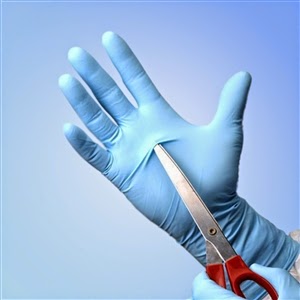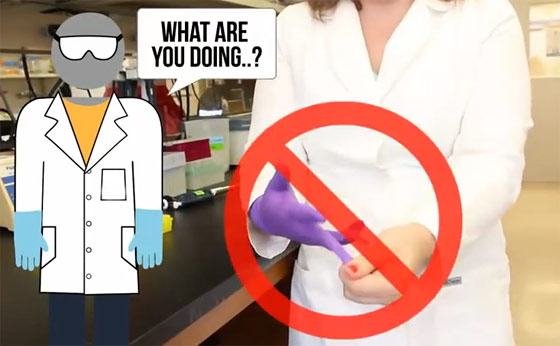So, I've been asked by a few different people "just what CAN we do to be safe from Ebola?"
Before I get into the details of PPE and other practices and procedures, I think it's worthwhile checking out some details on how you CAN'T get Ebola: I go to the CDC for all my Ebola guidance, and take their advice to heart. These are the people who know. Listen to the local guides ....
"In healthcare settings, Ebola is spread through direct contact (e.g., through broken skin or through mucous membranes of the eyes, nose, or mouth) with blood or body fluids of a person who is sick with Ebola or with objects (e.g., needles, syringes) that have been contaminated with the virus. For all healthcare workers caring for Ebola patients, PPE with full body coverage is recommended to further reduce the risk of self-contamination.
- Avoid contact with blood and body fluids of any person, particularly someone who is sick.
- Do not handle items that may have come in contact with an infected person’s blood or body fluids.
- Do not touch the body of someone who has died from Ebola."
That said, we're all about being prepared here, so in the interest of education and edification, here are some guidelines for how to protect against a virulent, non-airborne, aerosol-capable infective agent like the Ebola virus.
N95 Respirator: Here is what the FDA have to say about the N95 rating on a facemask, or respirator
"An N95 respirator is a respiratory protective device designed to achieve a very close facial fit and very efficient filtration of airborne particles. In addition to blocking splashes, sprays and large droplets, the respirator is also designed to prevent the wearer from breathing in very small particles that may be in the air.
To work as expected, an N95 respirator requires a proper fit to your face. Generally, to check for proper fit, you should put on your respirator and adjust the straps so that the respirator fits tight but comfortably to your face. For information on proper fit, refer to the manufacturer’s instructions.
The ‘N95’ designation means that when subjected to careful testing, the respirator blocks at least 95% of very small test particles. If properly fitted, the filtration capabilities of N95 respirators exceed those of face masks. However, even a properly fitted N95 respirator does not completely eliminate the risk of illness or death.
N95 respirators are not designed for children or people with facial hair. Because a proper fit cannot be achieved on children and people with facial hair, the N95 respirator may not provide full protection."
Sorry kids and Tactical Beard Owners ...
Nitrile Examination Gloves:
These tough and resistant gloves have a different feel to the more common latex examination glove, somewhat less tactile and more stiff, they have the become the standard for infection control PPE for this kind of situation.
Alcohol Based Hand Rubs are more effective against most bacteria and many viruses than either medicated or non-medicated soaps. Its common for me to squirt my hands with this stuff at work (even in my technical role) two or three times a day. It's ubiquitious at ever ward entrance and lift-well.
There is even some debate around alcohol-only ABHR versus alcohol-chlorhexidine ABHR: The addition of a low concentration of chlorhexidine to an ABHR results in significantly greater residual activity than alcohol alone and therefore potentially improves efficacy.
 Then there is the "what do I do if I really, really don't want to be exposed, clinical worker level protection. Guidelines from the CDC again:
Then there is the "what do I do if I really, really don't want to be exposed, clinical worker level protection. Guidelines from the CDC again: Recommended PPE for Trained Observer during Observations of PPE Doffing
The trained observer should not enter the room of a patient with Ebola, but will be in the PPE removal area to observe and assist with removal of specific components of PPE, as outlined below. The observer should not participate in any Ebola patient care activities while conducting observations. The following PPE are recommended for trained observers:- Single-use (disposable) fluid-resistant or impermeable gown that extends to at least mid-calf or coverall without integrated hood.
- Single-use (disposable) full face shield.
- Single-use (disposable) nitrile examination gloves with extended cuffs. Two pairs of gloves should be worn. At a minimum, outer gloves should have extended cuffs.
- Single-use (disposable) fluid-resistant or impermeable shoe covers. Shoe covers should allow for ease of movement and not present a slip hazard to the worker.
So, there you go: full fluid-proof gown, double-gloved, face-mask, booties. Even then, getting all this gear ON right isn't the only challenge. Getting it OFF again, when you have potientially been exposed is another task entirely. Which is why in hospital settings hey have those "Trained Observer" positions in the first place. All the PPE in the world isn't going to do you a lick of good if you rub that last contaminated piece of clothing on your face as you are getting it all off.
The University of Nebraska Medical Centre have these two excellent visual guides, which you may find useful:
Donning Visual Guide
Doffing Visual Guide
The question of "how long until it is safe to go back in there? "comes up: Again the CDC have all the answers:
How long does the Ebola virus persist in indoor environments?
Only one laboratory study, which was done under environmental conditions that favor virus persistence, has been reported. This study found that under these ideal conditions Ebola virus could remain active for up to six days. In a follow up study, Ebolavirus was found, relative to other enveloped viruses, to be quite sensitive to inactivation by ultraviolet light and drying; yet sub-populations did persist in organic debris.In the only study to assess contamination of the patient care environment during an outbreak, conducted in an African hospital under "real world conditions", virus was not detected by either nucleic acid amplification or culture in any of 33 samples collected from sites that were not visibly bloody. Virus was detected on a blood-stained glove and bloody intravenous insertion site by nucleic acid amplification, which may detect non-viable virus, but not by culture for live, infectious virus.3 Based upon these data and what is known regarding the environmental infection control of other enveloped RNA viruses, the expectation is with consistent daily cleaning and disinfection practices in U.S. hospitals that the persistence of Ebola virus in the patient care environment would be short – with 24 hours considered a cautious upper limit.
Lastly, for area and surface disinfection, the relatively simple method of 1:10 chlorinated bleach in water to decontaminate highly soiled areas, and 1:100 to spray, soak and pre-wash infected areas bedding and equipment, is believed to be highly effective.
So, be safe out there, but don't panic. There are far more common killers in the microbial world....
When
commercial
disinfectant
products
are
unavailable,
common
household
bleach
and
other
appropriate
disinfectants
may
be
effective
alternatives.
•
Use
a
1:10
solution
of
bleach
to
water
(e.g.,
1
cup
of
bleach
in
9
cups
o




















